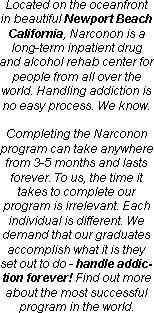
|
Navigate |
| Home |
| Kirstie Alley |
| Our 30th Anniversary |
| Never Turning Back |
| Narconon Endorsements |
| |
|
|
| |
|
|
| |
|
Facts About Drugs |
| FAQ About Ambien |
| FAQ About Ativan |
| FAQ About Cocaine |
| FAQ About Codeine |
| FAQ About Crack |
| FAQ About Darvocet |
| FAQ About Dexedrine |
| FAQ About Demerol |
| FAQ About Dilaudid |
| FAQ About Ecstasy |
| FAQ About GHB |
| FAQ About Heroin |
| FAQ About Hydrocodone |
| FAQ About Ketamine |
| FAQ About Lortab |
| FAQ About LSD |
| FAQ About Marijuana |
| FAQ About Morphine |
| FAQ About Meth |
| FAQ About Methadone |
| FAQ About Opiates |
| FAQ About Opium |
| FAQ About Oxycontin |
| FAQ About Percocet |
| FAQ About Percodan |
| FAQ About Ritalin |
| FAQ About Rohypnol |
| FAQ About Ultram |
| FAQ About Valium |
| FAQ About Vicodin |
| FAQ About Xanax |
  |
|
Resources |

|


 Print this article |  Send this article to a friend |  Add to Favorites |
FAQ
About Opiates
Q.) What are Opiates?
A.) Opiates, sometimes referred to as narcotics, are a group of drugs which are used medically to relieve pain, but also have a high potential for abuse. Some opiates come from a resin taken from the seed pod of the Asian poppy. This group of drugs includes opium, morphine, heroin, and codeine. Other opiates, such as meperidine (Demerol), are synthesized or manufactured. Opium appears as dark brown chunks or as a powder and is usually smoked or eaten. Heroin can be a white or brownish powder which is usually dissolved in water and then injected. Most street preparations of heroin are diluted, or "cut," with other substances such as sugar or quinine. Other opiates come in a variety of forms including capsules, tablets, syrups, solutions, and suppositories. Heroin ("junk" "smack") accounts for 90 percent of the opiate abuse in the United States. Sometimes opiates with legal medicinal uses also are abused. They include morphine, meperidine, paregoric (which contains opium), and cough syrups that contain codeine [or a synthetic narcotic, such as dextromethorphan].
Opiates tend to relax the user. When opiates are injected, the user feels an immediate "rush." Other initial and unpleasant effects include restlessness, nausea, and vomiting. The user may go "on the nod," going back and forth from feeling alert to drowsy. With very large doses, the user cannot be awakened, pupils become smaller, and the skin becomes cold, moist, and bluish in color. Breathing slows down and death may occur.
Q.) How are Opiates used?
A.) There are a number of synthetic opiates which are used as painkillers such as pethidine and methadone which is often prescribed for heroin and opiate addiction. Collectively opiates and synthetic opiates are called opioids.
Opioids powders can be swallowed or dissolved in water and injected, particularly into a vein which maximizes the effect. Heroin is sometimes sniffed, or the fumes from the heated powder is inhaled (this method is sometimes called "chasing the dragon").
Most opiates are taken orally, except heroin, which is in powder form. Heroin users generally begin sniffing the drug and gradually advance to injecting. The powder is dissolved in water and heated to produce a liquid. The user then injects the substance either subcutaneously or intravenously.
Subcutaneous injection ("skin popping") is when a heroin solution is injected into the layers of skin, usually in the arms or thighs. Intravenous injection ("mainlining") is when the heroin is injected into a vein. The effects of injecting heroin are felt within minutes and last three to four hours, depending on the dosage.
The large majority of heroin is illegally manufactured and imported, which originates largely from the Indian sub-continent. When sold at street level it is likely to have been diluted or cut with a variety of similar powders. The main dilutant is glucose. However, the practice of using other substances such as caffeine, flour and talcum powder is a constant danger to users.
Q.) What are the psychological effects of Opiates?
A.) Like other depressants, opiates produce a tranquil and euphoric effect. Users who inject an opiate such as heroin may also experience a "rush" as the drug circulates through the body. Some users combine opiates with a stimulant such as cocaine. This is called "speed balling." The stimulant keeps the user from falling asleep; the opiate reduces the hyperactive effects often caused by stimulants.
Psychological dependence is probable with continued use of opiates. When a user becomes dependent, finding and using the drug becomes the main focus of life. Opiates induce tolerance: the need for more of the drug in order to produce the same effects.
Q.) What are the physical effects of Opiates?
A.) The physical effects of opiates depend on the opiate used, its source, the dose and the method used. Opiates slow breathing, heart rate and brain activity. Opiates depress appetite, thirst and sexual desire. The body's tolerance to pain is increased. Potential contamination, using opiates in combination with other drugs, and using un-sterile needles all increase the danger of opiates. Use of un-sterile needles can lead to hepatitis, tetanus or AIDS.
Regular opiate users who abruptly stop using the drug experience withdrawal symptoms four to six hours following the last dose. Symptoms include uneasiness, diarrhea, abdominal cramps, chills, sweating, nausea, runny nose and eyes, irritability, weakness, tremors and insomnia. The intensity of these symptoms depends on how much of the drug was taken, how often and for how long. These symptoms are usually strongest 24 to 72 hours after onset and can persist for seven to 10 days.
Q.) What effects do Opiates have on pregnant women?
A.) Opiates are harmful to a developing fetus. Pregnant women who are dependent on opiates have a higher risk for spontaneous abortions, breech deliveries, premature births and stillbirths. Babies born to opiate-addicted mothers often have withdrawal symptoms similar to adults. These symptoms may last several weeks or months. Researchers have also found an increased risk of Sudden Infant Death Syndrome (SIDS) among babies born to heroin-addicted mothers.
Q.) What are some signs and symptoms of Opiate use?
A.)
|
Q.) Are Opiates addictive?
A.) Long-term use of opioids causes tolerance to develop so that in order to achieve the same degree of euphoria, larger and larger doses must be taken. When people have been off the drug for some time their tolerance decreases and a common cause of death results from a user taking the same amount of drug used before they stopped or cut down.
When high doses have been taken for several weeks, a sudden withdrawal causes symptoms of discomfort similar to flu. These include aches, sweating and chills, tremor, sneezing and yawning and muscular spasms, all or some of which usually commence between 8 and 24 hours after the last dose of heroin. Although these effects usually fade within 7 to 10 days, feelings of weakness and loss of well being can last for several months.
Physical dependence is easier to overcome than psychological dependence, which some long-term users develop, although dependence of any kind is not a certainty. Some people can use heroin on an occasional basis and not become addicted.
Prolonged usage can cause physical damage to the body, although not necessarily from the drug itself. Repeated injections with dirty needles can result in diseases such as Hepatitis, AIDS and Tetanus, especially when sharing needles. There is also a risk of using impure drugs which have been mixed with unknown substances. Repeated sniffing of heroin damages the nose.
Apathy and reduced appetite caused by drug use can lead to disease as a result
of a poor diet, self neglect and bad housing conditions. The increasing cost of
satisfying tolerance / dependence can lead to money problems which can result
in self neglect and major social problems.
If you have a problem with opiate addiction call Narconon Southern California drug rehab center, we can help 1800 US NO DRUGS

comment corner
 |
| drug rehabilitation saving taxpayers |
California taxpayers are saving more money than expected due to ... |
 |
| Study: Marijuana Causes Lung Damage |
New research finds that smoking three or four marijuana cigarettes ... |
 |
| Thanks to Online Pharmacies, Addiction Can Be Just a Click Away |
WASHINGTON -- Kelly Knable, a 34-year-old mother of three from ... |
 |
| Balancing pain and drug addiction |
Over the past two decades, two conflicting medical ideas have ... |
 |
| Clean break |
... |
 |
| State officials create prescription drug abuse task force |
TALLAHASSEE, Fla. -- State officials on Friday announced the creation ... |
 |
| Florida system often fails to catch Medicaid abuse at source |
FORT LAUDERDALE, Fla. - (KRT) - The victim's skin was ... |
 |
| Marijuana's rising threat: For more kids, use turns into addiction |
John Brown experimented with marijuana at age 10, and it ... |
 |
| Student gets state prison term for selling marijuana |
EASTON -- David Messina had his whole life ahead of ... |
 |
| Man charged in cocaine case forfeits $585,000 |
An Iowa truck driver arrested by Kentucky Vehicle Enforcement officers ... |
 |
| Cocaine Curtails Body's Ability to Cool Off |
In addition to triggering life-threatening cardiovascular episodes, cocaine can be ... |
 |
| Science for Cops |
I admit it: I'm a Law & Order fan. ... |
 |
| New Gene Therapy Could Help Quell Alcoholic Cravings |
One prevailing view of addiction holds that alcohol and other ... |
 |
| One Dose of Cocaine Primes the Brain for Addiction |
It isn't a myth: one dose of cocaine is all ... |
 |
| Marijuana Firmly Linked to Infertility |
Scientists from the University of Buffalo have smoked out what ... |
 |
| Moderate Alcohol Consumption Clouds Brain's Ability to Detect Mistakes |
It's common knowledge that a brain on booze doesn't function ... |
|
Narconon Pictures |
|
   |
|